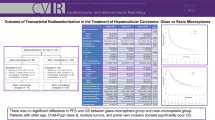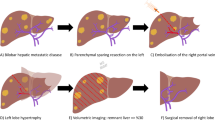Abstract
Purpose
Diffuse infiltrative hepatocellular carcinoma (D-HCC) is an incurable disease with short survival time. Transarterial chemoembolization (TACE) was often used to alleviate patient’s symptoms and reduce tumor burden. However, it remains unknown if the TACE benefits the survival of D-HCC patients.
Methods
A hospital-based retrospective study was conducted at a large referral hospital in Taiwan for a 9-year period (2000–2008).
Results
Of the 150 D-HCC patients, 106 patients were related to hepatitis B virus (HBV), 17 to hepatitis C virus (HCV), 3 to both HBV and HCV, and 24 not to HBV or HCV. Multivariate Cox regression analysis showed treatment strategy, serum alpha-fetoprotein level, model for end-stage liver disease (MELD) score, serum gamma glutamyl transferase, and serum lactic acid dehydrogenase were associated with survival time. Compared to supportive treatment, the adjusted hazard ratios of transarterial chemoembolization (TACE) and chemotherapy including oral or systemic chemotherapy were 0.383 (p < 0.001) and 0.711 (p = 0.289), respectively.
Conclusion
TACE is a preferred therapy for D-HCC patients.

Similar content being viewed by others
References
Okuda K, Noguchi T, Kubo Y, et al. A clinical and pathological study of diffuse type hepatocellular carcinoma. Liver 1981;1:280–289
Yuki K, Hirohashi S, Sakamoto M, et al. Growth and spread of hepatocellular carcinoma. A review of 240 consecutive autopsy cases. Cancer 1999;66:2174–2179
Trevisani F, Caraceni P, Bernardi M, et al. Gross pathologic types of hepatocellular carcinoma in Italian patients. Relationship with demographic, environmental, and clinical factors. Cancer 1993;72:1557–1563
Myung SJ, Yoon JH, Kim KM, et al. Diffuse infiltrative hepatocellular carcinomas in a hepatitis B-endemic area: diagnostic and therapeutic impediments. Hepatogastroenterology 2006;53:266–270
Lee SD, Lee FY, Wu JC, et al. The prevalence of anti-hepatitis C virus among Chinese patients with hepatocellular carcinoma. Cancer 1992;69:342–345
Chuang WL, Chang WY, Lu SN, et al. The role of hepatitis B and C viruses in hepatocellular carcinoma in a hepatitis B endemic area. A case–control study. Cancer 1992;69:2052–2054
Bruix J, Sherman M, Practice Guidelines Committee, American Association for the Study of Liver Diseases. Management of hepatocellular carcinoma. Hepatology 2005;42:1208–1236
Bruix J, Sherman M, Llovet JM, EASL Panel of Experts on HCC, et al. Clinical management of hepatocellular carcinoma. Conclusions of the Barcelona-2000 EASL conference. European Association for the Study of the Liver. J Hepatol 2001;35:421–430
Kanematsu M, Semelka RC, Leonardou P, et al. Hepatocellular carcinoma of diffuse type: MR imaging findings and clinical manifestations. J Magn Reson Imaging 2003;18:189–195
Wiesner R, Edwards E, Freeman R, et al. Model for end-stage liver disease (MELD) and allocation of donor livers. Gastroenterology 2003;124:91–96
Stuart K, Tessitore J, Huberman M. 5-Fluorouracil and alpha-interferon in hepatocellular carcinoma. Am J Clin Oncol 1996;19:136–139
Okazaki N, Yoshino M, Yoshida T, et al. Systemic chemotherapy of hepatocellular carcinoma. Gan To Kagaku Ryoho 1986;13:1584–1588
Ihde DC, Matthews MJ, Makuch RW, et al. Prognostic factors in patients with hepatocellular carcinoma receiving systemic chemotherapy. Identification of two groups of patients with prospects for prolonged survival. Am J Med 1985;78:399–406
Komorizono Y, Kohara K, Oketani M, et al. Systemic combined chemotherapy with low dose of 5-fluorouracil, cisplatin, and interferon-alpha for advanced hepatocellular carcinoma: a pilot study. Dig Dis Sci 2003;48:877–881
Boucher E, Corbinais S, Brissot P, et al. Treatment of hepatocellular carcinoma (HCC) with systemic chemotherapy combining epirubicin, cisplatinum and infusional 5-fluorouracil (ECF regimen). Cancer Chemother Pharmacol 2002;50:305–308
Noda I, Kitamoto M, Nakahara H, et al. Regular surveillance by imaging for early detection and better prognosis of hepatocellular carcinoma in patients infected with hepatitis C virus. J Gastroenterol 2010;45:105–112
Oka H, Saito A, Ito K, et al. Multicenter prospective analysis of newly diagnosed hepatocellular carcinoma with respect to the percentage of Lens culinaris agglutinin-reactive alpha-fetoprotein. J Gastroenterol Hepatol 2001;16:1378–1383
Sterling RK, Jeffers L, Gordon F, et al. Clinical utility of AFP-L3 % measurement in North American patients with HCV-related cirrhosis. Am J Gastroenterol 2007;102:2196–2205
Leerapun A, Suravarapu SV, Bida JP, et al. The utility of Lens culinaris agglutinin-reactive alpha-fetoprotein in the diagnosis of hepatocellular carcinoma: evaluation in a United States referral population. Clin Gastroenterol Hepatol 2007;5:394–402
Marrero JA, Su GL, Wei W, et al. Des-gamma carboxyprothrombin can differentiate hepatocellular carcinoma from nonmalignant chronic liver disease in American patients. Hepatology 2003;37:1114–1121
Nakamura S, Nouso K, Sakaguchi K, et al. Sensitivity and specificity of des-gamma-carboxy prothrombin for diagnosis of patients with hepatocellular carcinomas varies according to tumor size. Am J Gastroenterol 2006;101:2038–2043
Volk ML, Hernandez JC, Su GL, et al. Risk factors for hepatocellular carcinoma may impair the performance of biomarkers: a comparison of AFP, DCP, and AFP-L3. Cancer Biomark 2007;3:79–87
Sawabe M, Nakamura T, Kanno J, et al. Analysis of morphological factors of hepatocellular carcinoma in 98 autopsy cases with respect to pulmonary metastasis. Acta Pathol Jpn 1987;37:1389–1404
Shijo H, Okazaki M, Higashihara H, et al. Hepatocellular carcinoma: a multivariate analysis of prognostic features in patients treated with hepatic arterial embolization. Am J Gastroenterol 1992;87:1154–1159
Lo CM, Ngan H, Tso WK, et al. Randomized controlled trial of transarterial lipiodol chemoembolization for unresectable hepatocellular carcinoma. Hepatology 2002;35:1164–1171
Livraghi T, Giorgio A, Marin G, et al. Hepatocellular carcinoma and cirrhosis in 746 patients: long-term results of percutaneous ethanol injection. Radiology 1995;197:101–108
Llovet JM, Bruix J. Systematic review of randomized trials for unresectable hepatocellular carcinoma: chemoembolization improves survival. Hepatology 2003;37:429–442
Ohto M, Yoshikawa M, Saisho H, et al. Nonsurgical treatment of hepatocellular carcinoma in cirrhotic patients. World J Surg 1995;19:42–46
Seror O, N’Kontchou G, Haddar D, et al. Large infiltrative hepatocellular carcinomas: treatment with percutaneous intraarterial ethanol injection alone or in combination with conventional percutaneous ethanol injection. Radiology 2005;234:299–309
Jeon SH, Park KS, Kim YH, et al. Incidence and risk factors of acute hepatic failure after transcatheter arterial chemoembolization for hepatocellular carcinoma. Korean J Gastroenterol 2007;50:176–182
Carr BI, Irish W, Federle MP. Chemoembolization for unresectable hepatocellular carcinoma in patients with or without portal vein thrombosis. Hepatogastroenterology 2010;57:1375–1381
Hsu KY, Chau GY, Lui WY, et al. Predicting morbidity and mortality after hepatic resection in patients with hepatocellular carcinoma: the role of model for end-stage liver disease score. World J Surg 2009;33:2412–2419
Iacob S, Gheorghe L, Iacob R, et al. MELD exceptions and new predictive score of death on long waiting lists for liver transplantation. Chirurgia 2009;104:267–273
Limquiaco JL, Wong GL, Wong VW, et al. Evaluation of model for end stage liver disease (MELD)-based systems as prognostic index for hepatocellular carcinoma. J Gastroenterol Hepatol 2009;24:63–39
Author information
Authors and Affiliations
Corresponding author
Rights and permissions
About this article
Cite this article
Hung, TH., Tsai, CC., Lin, CC. et al. Is transarterial chemoembolization beneficial for patients with diffuse infiltrative hepatocellular carcinoma?. Hepatol Int 7, 676–682 (2013). https://doi.org/10.1007/s12072-012-9392-1
Received:
Accepted:
Published:
Issue Date:
DOI: https://doi.org/10.1007/s12072-012-9392-1




